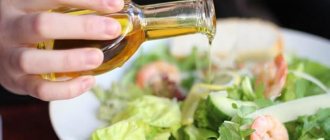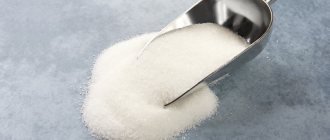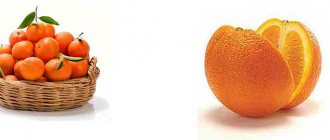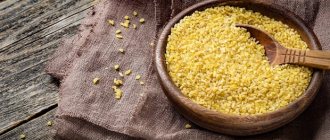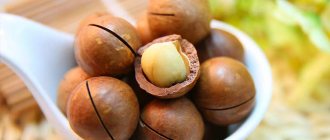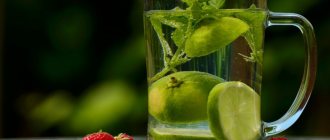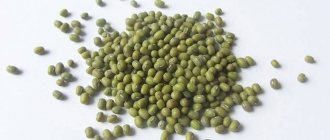Composition and nutritional value of soybeans
The plant has become popular in vegetarian nutrition thanks to soy protein, the benefit of which is its ability to replace meat and dairy products. The calorie content of 100 g of beans is 446 kcal. Composition (in g):
- carbohydrates – 30.16;
- fats – 19.94;
- proteins – 36.49;
- water – 8.54;
- ash – 4.87.
The benefits of soybeans and their properties are explained by their chemical composition:
- vitamins – B, C, E, K, D, PP;
- macroelements – potassium, calcium, silicon, chlorine, phosphorus, magnesium, sulfur;
- microelements – iron, manganese, boron, aluminum.
Calorie content and chemical composition
Soy, like no other plant product, has an extremely rich chemical composition. Per 100 grams of raw material, the grain of this representative of the Legume family contains 36.7 g of protein, 17.3 g of carbohydrates, there are even fats - 17.8 g, including Omega-3 and Omega-6 fatty acids, which make up more than half all fats. There is only 12 g of water in 100 g of product, 13.5 g of fiber.
In addition to the high percentage of protein, the chemical composition of soy can highlight vitamins and minerals, which are contained there in large quantities. For example, by eating just 100 g of product, you can satisfy the daily requirement for vitamins such as B1, B4, B5, B6, B9, PP by 35-65%, and vitamin H by as much as 120%. In addition to these substances, soy contains vitamins B2 and E (12% of the daily value each) and small amounts of retinol and carotene (less than 2%).
There are also plenty of minerals in soybeans. In 100 g of product you can find from 1/3 to 2/3 of the daily requirement of elements such as potassium, calcium, magnesium, sulfur, phosphorus, iron, copper, chromium and zinc. There is even more manganese, molybdenum, cobalt and silicon - there are so many of them in soybeans that 100 g of the product can cover from 140 to 590% of the daily human requirement for these minerals.
In addition to being rich in vitamins and minerals, the product is distinguished by its nutritional value. The calorie content of soy is 364 kcal, which makes it one of the highest calorie foods of plant origin. Soybeans are also known for their nutritional value, which consists of a large amount of complete protein, the quality of which is close to animal, minerals and vitamins, and high overall nutritional value.
What are the benefits of soy for the body?
Vitamins A and E contained in beans have antioxidant properties and neutralize the harm of toxins. The benefit of B vitamins is to improve metabolism and the functioning of all organs. Lecithin is especially important for those losing weight: it accelerates metabolism and reduces the level of “bad” cholesterol. The bile ducts are cleansed thanks to phospholipids; triglycerides are a source of energy for humans. Isoflavones prevent the formation of cancer cells, tocopherol has the ability to strengthen the immune system and fight aging. The beneficial properties of soy reduce the risk of diabetes, cardiovascular pathologies, liver diseases, and allergies to animal protein.
For men
At the end of the last century, research was conducted at Harvard, but scientists are still arguing about the benefits and harms of soy for men’s health and cannot come to a consensus. It is assumed that when consuming beans, testosterone decreases, hormonal balance and sexual functions are disrupted, and fewer sperm are produced. But in practice, a large amount of protein increases the volume of sperm, while the number of sperm does not change, only their concentration nominally decreases.
It has been proven that vitamin E is directly involved in the formation of male semen, and its deficiency affects the blood vessels and nervous system. It helps prevent prostatitis, heart attack, neurosis - these diseases have become common in men. The benefits of soy for men are observed with moderate consumption. Doctors recommend daily inclusion of the product in the diet in a volume of 20 g; there is no harm from its use, and the risk of atherosclerosis and heart attack is significantly reduced.
For women
As a result of research and practical observations, the benefits of soy for women's health have been proven. During menopause, hormone therapy can be replaced by eating soybeans to maintain estrogen levels. 100 g of product contains the daily requirement of isoflavones necessary to correct hormonal levels. They have the properties to overcome premenstrual syndrome and unpleasant symptoms during menopause. The use of soy prevents the development of breast cancer and osteoporosis. Lecithin, which is part of beans, prevents the accumulation of fat in the liver and helps normalize weight.
Composition and benefits of the product
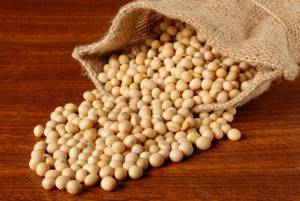
are a high-protein product that is also quite high in calories - 100 grams of dried soybeans account for 440 kilocalories. In terms of protein content, soybeans are superior to beans, peas and other legumes.
Composition of the product:
- Protein – about 37 grams;
- Fats – 20 g;
- Carbohydrates – 30 g, including sugar – 7 grams.
Therefore, it is important to eat soybeans as an energy-rich and high-protein product. And, of course, the benefits of soy products containing healthy fatty acids speak of soy as an exceptional product for women's health, beauty of hair, nails, and youthful skin. And the presence of fiber makes the product indispensable for diabetics and anyone who wants to lower cholesterol.
The presence of beneficial minerals and vitamins in beans brings soy even closer to an ideal product for everyone, although there are exceptions, and we will talk about contraindications a little later. And now we propose to study the vitamin composition of mature soybeans.
Content of vitamins and minerals (100 grams of mature soybeans):
- Retinol (Vit. A) – 1 mcg
- Pyridoxine (B6) - 0.40 mg
- Vitamin B9 - 375 mcg
- Vitamin C 6 mg
- Calcium about 280 mg
- Iron contains about 16 mg
- Magnesium – 290 mg
- Phosphorus – 705 mg
- Record amount of potassium - 1797 mg
- Sodium about 3 mg
- Zinc – 5 mg
Based on the composition of the product, we see that the product is indispensable for heart patients and people suffering from vascular diseases. It strengthens bones due to its phosphorus content and prevents osteoporosis. Due to the presence of magnesium, the product is useful for nervous disorders. And the content of isoflavones, phytosterols and phospholipids has a beneficial effect on the female body.
It is known that in the USA they have been producing soybean products for years, but they do not use the beans as food. Only the fat is extracted from them, and then the cake is used for further processing. Soybean oil is used to prepare dietary dishes. The cake is very rich in protein, so soy meat and other products are produced from it. The cake is also fed to animals.
Naturally, when people buy, for example, sausage or dumplings, they do not suspect that, in fact, they will be eating products containing soy, is this good or bad? There is no harm in the product if it has been tested by a laboratory. This does not mean that GMOs are present in every package of soy meat or milk. But still, when choosing a product as food, you should pay attention to the manufacturer and trust trusted companies.
Asians eat soybeans with iodine-containing foods - vegetables, seaweed, seafood ... That's why the Japanese look healthier and feel more energetic, and it's not for nothing that Japan is considered a country of long-livers.
Soy products

Are you interested in the question of which products contain soy most often? The best foods containing soy :
- tofu cheese,
- Soy meat,
- soy milk,
- yoghurts,
- soy sauce,
- soybean oil,
- soy flour.
Soybeans are also added to food products such as cutlets, dumplings, sausages, etc. If you are interested in soy products, where to buy them, they are sold in sports nutrition stores and on supermarket shelves among products for diabetics.
Soybean is very popular in India, a variety of dishes are prepared from it, and Indians are always cheerful and healthy, because their diet already includes healthy beans.

Indian dish made from pieces of soy meat, coconut milk, spices and vegetables.
In Japan and China, soybeans are also very popular; they prepare numerous dishes from it. They also use milk, a soy drink; the benefits of soy products are highly valued there. Soybeans are used to prepare various sauces, pastes, and soups. In the USA and Indonesia, a popular dish is called "Tempe", and in Japan - "Edamame" - these are boiled green soybean pods, soy flour, butter, fuju (milk film), natto, and soy sauce are also used.
As you can see, soy appears quite often in food products. And dishes made from it are very healthy and tasty. In Japanese everyday life, misu soup is generally considered a panacea for all diseases, and in this the Japanese differ from the Europeans - they are healthier and stronger every year.
Soy protein - benefits and harms
If we consider soybeans from a nutritional point of view, they are superior to beans in protein content (per 100 grams of beans there are 23 g of protein, and soybeans - 37 g). And protein, as is known, is a unique building material for the cells and blood of the human body . And this is not a simple protein, but a textured plant protein that helps people with various diseases if they are allergic to animal protein.
Also, due to its protein content, and the benefits of soy proteins are underestimated, soy perfectly saves athletes from overload and helps build muscle mass. For those trying to lose weight, soy protein also helps improve their diet.
Soy controls weight
Soybeans exhibit a two-way effect in that consumption of the product helps those who want to gain a few kilograms and lose weight, and those who want to lose weight. This is surprising, but true. For diabetics, this is a big plus - soy is very nutritious, at the same time, phytosterols help lower cholesterol levels by blocking its absorption by the body.
Fiber does an excellent job of moving food through the gastrointestinal tract, which is why soy is recommended for constipation. In addition to improving digestion, fiber helps prevent colon cancer.
For heart health
Thanks to its record potassium content, soy controls heart attacks, and dietary fiber in large quantities scrapes cholesterol from the walls of capillaries and strengthens blood vessels. Linoleic and lanolinic acids also affect smooth muscles and help lower blood pressure.
Soy also acts as a sedative because it contains folic acid and magnesium. These elements are directly related to the human nervous system. If you have mood swings or simply fall asleep for a long time, it is better to replenish your body's reserves with soy.
Soy during pregnancy and breastfeeding
There is an opinion that the benefits of soy for a woman’s health during pregnancy are completely absent and the product is even harmful. The statement is incorrect, because due to the high protein content in beans, the fruit develops fully. The properties of lecithin allow the normal intrauterine formation of the baby's nervous system, iron promotes hematopoiesis.
People of the USA, Europe, and Asia use soybeans as food during pregnancy, but no complications or deviations were noticed. To obtain benefits, consumption of soybeans should be moderate: 1 - 2 cups of soy milk per day is enough.
During breastfeeding, it is necessary to take a responsible approach to introducing a new product into the diet. If after trial use (no more than one teaspoon) the baby does not experience a reaction in the form of diarrhea or rashes, then there are no prohibitions on use. Gradually the amount can be increased. During breastfeeding, the daily norm is 60 g, twice a week. With this approach, the woman and baby receive only the benefits of soy products. Consultation with a doctor is necessary.
Soy products and their benefits
Despite the bad reputation of consumers, soybeans are used in the production of a large number of food products: soy milk, soy meat, sauces and pastes, soy flour, candies and bars, cheeses (Tofu) and has its fans. If you are among them, there is no reason to worry if you have a properly balanced diet.
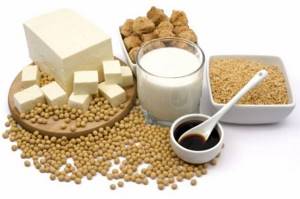
Based on what has been said, I will summarize that soy in moderation, like all products given to us by nature, should be present in our diet. And all the hype around the dangers of soy is an invention absolutely unfounded. There are many more harmful products, such as sauces, chips, crackers with preservatives and flavor enhancers, sweet carbonated drinks, lollipops, the same sausages with a lot of “eats” and other synthetic ingredients, the harm of which is obvious. However, for some reason it was soybeans that came under fire.
Although, in the countries of Europe and America, soybeans are mostly GM and are widely used as food; they are more popular than here. Numerous tests and scientific studies have not confirmed the harm of soybeans. All the fuss around the product does not correspond to the scale of the problem.
To be honest, I’m not a fan of this product, but Tofu soy cheese tastes good to me.
And don’t be afraid of soy, eat soy products in moderation and be healthy! Or do you have a different opinion? Share with friends:
Is soy good for children?
It is worth finding out whether soy should be included in a child’s diet, whether the product is beneficial or harmful to the child’s body.
Beans, containing complete protein and oil, contribute to the growth of the body, activation of metabolism, and the formation of the skeleton. For children under one year of age, healthy formulas containing soy are produced. They have anti-allergenic properties and include the entire complex of essential vitamins and microelements. Recommended for those intolerant to cow's milk. The mixture should be introduced gradually over a week, after consulting with your pediatrician.
Soy products also have a beneficial effect on infections accompanied by diarrhea. The stool quickly returns to normal. Despite the medicinal properties of soy, in some cases it is worth refraining from consuming it:
- with congenital hypothyroidism;
- premature babies;
- malnutrition.
Drawing conclusions about the benefits and harms of soy
So what should we do, eat soy products or avoid them?
There is no unity in scientific circles; soybeans have become the talk of the town for many doctors. One thing is for sure - for healthy people, moderate consumption of soy is safe , if it is, of course, grown in environmentally safe places.
We also do not forget that genetically modified soybeans can harm the body, so you need to be careful when purchasing soybean semi-finished products.
If you really do consume it, you should opt for fermented foods - miso soy paste, high-quality soy sauce, meat, unrefined soybean oil, Tofu cheese, and not be tempted by soy-based food additives in sausages. And don’t eat kilos of it; in maintaining health, moderation and sanity are more valued.
Soy for weight loss
Despite the high calorie content of the product, the soy diet is effective. This is due to the high content of lecithin in beans, which has a choleretic effect and can lower cholesterol and reduce appetite. For cellulite, soybean sprouts should be included in the diet, the benefit of which lies in their ability to renew skin cells, eliminate sagging, and make it elastic.
Due to the complete absence of fat in soy, dishes made from it are dietary. Meat, milk, cheese, butter, cottage cheese and other soy products are used to prepare them. Vegetables and cereals can be seasoned with sauce or bean paste.
Protein, which is abundant in the plant, is remarkably absorbed, strengthening muscles. But we must not forget about regular physical activity.
Due to phytoestrogens, analogues of female hormones, the soy diet is contraindicated:
- in case of thyroid dysfunction;
- during pregnancy;
- girls in adolescence.
Soy in sports nutrition
Despite the debate about the benefits and harms of soy products, the protein obtained from the plant's beans is the basis of sports nutrition. It is important for those involved in bodybuilding and fitness. Soybean isolate is used as a source of protein, supplying the cells with amino acids and giving them energy. The protein-rich nutritional supplement can be taken diluted with water or juice. It is important to follow the dosage and manufacturer's instructions. Otherwise, the benefits of soy protein will be completely neutralized, and an overdose will harm the digestive organs.
Protein is consumed an hour before or after training. This is necessary to nourish the muscles of an athlete experiencing heavy loads. Consultation with a doctor is required.
We recommend reading: What are the benefits of peanut butter, composition and calorie content?
Background of soybean cultivation
Soybean is a plant of the legume family, brought to us from China and India, where it has been grown for at least 5 thousand years. In Russia, this unpretentious plant began to be grown en masse and used in food production since the 70s of the last century. Our soybeans are grown in the Far East - Primorsky Territory, there are fields in the Stavropol and Krasnodar Territories, where there is a lot of moisture, heat and fairly long daylight hours. We export most of the soybeans, using little of it in the production of our own food products.
Products containing soy
Soy is included in most food products. It is included in semi-finished products, sausages, confectionery products, milk, and baby cereals. In addition to products with low soy content, there is a range made directly from beans:
- flour - the basis of meat and noodles, produced by grinding grains;
- oil - obtained by extraction from soybeans, serves as the basis for margarine;
- milk is a product for infants, which is created by soaking and grinding beans;
- sauce – enhances the taste of dishes, it is produced by breaking down starch;
- tofu cheese - used as cottage cheese.
Recommended reading: Health Benefits of Tofu Cheese
The benefits of sprouted soybeans
Soybean sprouts are easy to obtain at home from beans. This will take no more than a week. They are ready when they reach a length of 4 cm. If we compare the benefits and harms of sprouted soybeans, the percentage ratio is 100:1. Contraindication is an allergy to the product. Among the beneficial components of sprouts:
- amino acids;
- cellulose;
- microelements,
- vitamins,
- choline,
- lecithin.
The benefits of soybean sprouts for children, the elderly, and women during pregnancy and lactation cannot be overestimated. It is recommended to eat them not raw, but after blanching for 5 minutes. Bean sprouts allow you to:
- cleanse the vessels;
- improve sleep;
- strengthen the nervous system;
- free the liver and intestines from toxins;
- improve memory;
- restore brain cells.
Since the calorie content of sprouts is only 30 kcal per 100 g of product, their beneficial properties can be used during a diet.
Beneficial properties of soybeans
Soybean is the record holder for the content of vegetable protein; its presence in some varieties reaches 90%. Soy protein in its structure and properties is equal to protein of animal origin, due to the content of all nine amino acids necessary for the body. In terms of the amount of vegetable protein, soybeans are superior to eggs, fish, and beef.
1 kg of soybeans replaces 80 eggs or 3 kg of beef!
Soy is indicated in the diet of the following categories of people:
- vegetarians;
- raw foodists;
- people who are allergic to meat;
- patients with type II diabetes mellitus;
- women during menopause;
- fasting people;
- weight watchers and dieters.
The advantage of soy is that while animal protein increases cholesterol levels in the blood, plant protein regulates it and reduces it by 30%.
Why soy is harmful
There is no single point of view among scientists regarding the dangers of soy. Among the scientifically unsupported arguments:
- eating beans contributes to brain shrinkage and the development of Alzheimer's disease;
- accelerated aging;
- complications of pregnancy;
- and also contraindicated for children;
After testing, no harm to the product for the human body was revealed. It has also been established that many positive properties are overly exaggerated. However, the benefits of soy protein for men, women and children are obvious.
Why are genetically modified soybeans dangerous?
Scientists have created beans with altered DNA to resist extreme weather conditions, diseases, and pests. To this end, they add or remove the corresponding genes in soybeans. The consequences of consuming such products by people have not yet been studied. Experiments were carried out on animals, which in a number of cases resulted in the detection of gastrointestinal inflammation, cancer, and immunity disorders.
Genetic modification of soybeans is a way to increase crop yields in order to provide nutrition to the growing world population. Proponents of the harmlessness of GMOs argue that 20 years of using soy products have not caused harm to humans. At least this is not reflected in WHO reports.
How to select and store soybeans
Buying soybeans by weight or in transparent packaging will allow you to examine and evaluate the quality of the product:
- there should be no litter in the bag;
- bean shape - round or oval;
- the grains are dry, undamaged;
- the surface is smooth;
- moderately hard beans;
- The label must contain information about the manufacturer, expiration date, and storage conditions.
Experts recommend preparing dishes from light-colored soybeans: dark ones are considered feed. The product must be stored in a dry, dark place at room temperature in a cloth bag. You shouldn’t mix beans you just bought and those you bought a long time ago. Maximum storage time is 1 year at a humidity of no more than 14%. After the expiration date, the product cannot be used.
Properties of soy that should be considered when choosing it
When selecting soybeans, it is necessary to inspect the product - it should be free of mold, dark spots, signs of caking and rotting. The beans should be dry, clean, and their shell should be dense and shiny. Soybeans are sold in stores in packaged packages, similar to beans or peas. There should be nothing foreign in the bag of beans - stems and other plant debris.
Soybeans can be sold as okara, a moist, curd-like mass with a yellowish tint. It is formed after boiling and grinding pre-soaked soybeans. Okara has no taste or aroma; it serves as the basis for many dishes - cutlets, bread, desserts. This soy mass can be stored in the refrigerator without loss of taste and beneficial properties.
When choosing soy and soy-based products, you should consider the above recommendations in order to get maximum benefits for the body and not harm your health.
Thanks for sharing with your friends!
